Anne Teresa De Keersmaeker and Boris Charmatz perform her Partita 2 in Lincoln Center’s White Light Festival.
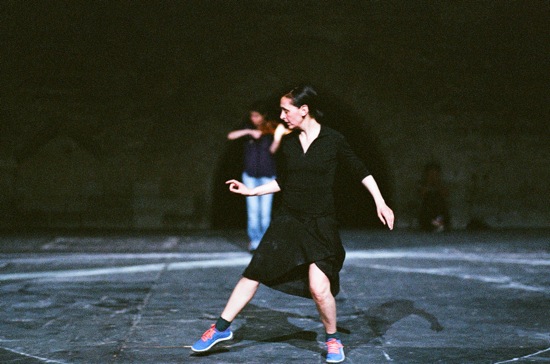
Anne Teresa De Keersmaeker in a performance of her Partita 2 in Avignon. At back: violinist Amandine Beyer. Photo: © Anne Van Aerschot
Anne Teresa De Keersmaeker’s Brussels-based company, Rosas, last performed in New York in 2013, when the Brooklyn Academy of Music presented her En Attendant and Cesena. Several years before, the two stunning pieces, featuring singers and instrumentalists as well as dancers, had premiered in Avignon, and there the selections of medieval music had resonated in the ancient Cloister of the Celestines (En Attendant) and in an amphitheater connected with the palace occupied by the Pope during the years of the Papal Schism (Cesena).
Also in 2013, this profoundly fascinating choreographer made one of her smallest works: a duet for herself and French choreographer-performer Boris Charmatz, set to Johann Sebastian Bach’s Partita No.2 in D minor (1720). The word “duet” is accurate, but also misleading. In the performances that were part of Lincoln Center’s White Light Festival, the superb violinist Amandine Beyer played onstage the movements that make up Bach’s suite of dances (Allemande, Courante, Sarabande, Gigue, and Chaconne). So: a trio.
In fact, call De Keersmaeker’s Partita 2 a quartet. It begins with a door opening on one side of the Gerald W. Lynch Theater in John Jay College, and the resultant beam of light from the wings lays a diagonal avenue across the stage. Beyer walks in, reaches a spot in the center of the space, and the door closes. In darkness we sit and listen while she plays. Hearing an unseen musician is an experience both intense and serene. Uncluttered. Bach is with us. In fact, when, during the dance that follows, De Keersmaeker and Charmatz occasionally pause and gaze into the space directly above their heads, I imagine them checking to see if the composer’s spirit approves.
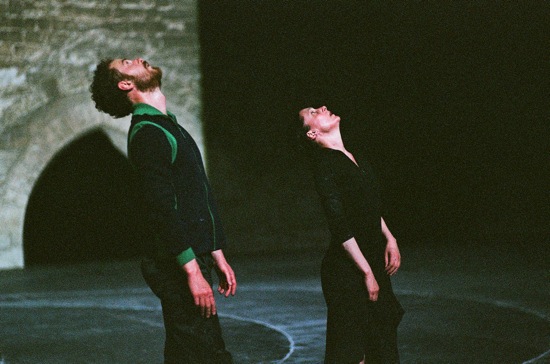
Boris Charmatz and Anne Teresa De Keersmaeker in a performance of Partita 2 in Avignon. Photo: © Anne Van Aerschot
Partita 2 lasts for 75 intermission-less minutes, while the music can be played in a little over a half-hour. Beyer doesn’t perform all of it to begin with—just the first four movements, which consume under 15 minutes). After the frenzy of the Gigue, she marches off the stage on the opposite side from which she entered and from which De Keersmaeker and Charmatz make their appearance. What we don’t yet know is that they will dance in silence for about a half hour, after which Beyer will reappear and play the entire Partita while they dance. So we hear a virtual dance that we cannot see, then see a dance—perhaps remembering the music—and finally absorb them together.
The dance in silence and the dance with music may not be exactly identical, but movements from the first reappear—perhaps varied—in the second. A description on Rosas’ website paraphrases De Keersmaeker (or at least hints at how she thinks about the musical forms in relation to the dance): “allemande will make us step, in courante we will run, in sarabande we will fold in various patterns, and the relentless chaconne will let us run in circles jubilantly together!” She understands the structure of Bach’s music and its relation to baroque dance forms better than I do; I only know that her choreography reflects those elements in ways that are deeply sympathetic, yet comradely enough to be playful. In an interview printed in the program, Charmatz spoke of Bach’s architecture as a “mountain that has to be climbed” yet whose summit is in a sense unattainable: “we are trying, rather, to introduce a ‘vibration,’ a slight hesitation in the face of the absolute perfection of the music.”
They’re an interesting pair. De Keersaeker, now in her fifties, is lean, strong, and slightly severe in manner; Charmatz is younger, bearded, and seems a little more impulsive—puppyish even. Both wear simple black or white clothes by Anne-Catherine Kunz, which they alter during the dance, either removing an over-garment onstage or going offstage to make a slight change. They dance as if intent on a task to be fulfilled—always aware of each other, even when embarking on separate swatches of dancing. And their very truthfulness, not to mention their skill, makes them mesmerizing to watch. Our ears have been primed; now the eyes wake up.
But, of course, we’re still hearing things—possibly replaying Bach in our heads, but more likely aware of the footfalls, the humming the performers occasionally do under their breaths, and the inadvertent sniff or grunt. Walking plays an important part in the dance, just as a walking bass line often figures in the music. De Keersmaeker and Charmatz also run. Perhaps they’re side by side; perhaps one leads and the other follows. Call these motifs. Chalked circles on the floor guide their paths.
But their travels also incorporate pauses and hesitations, and they do much more than walk and run. Charmatz occasionally leaps, bundles himself into a jump, rolls on the floor, or lifts a bent leg high and turned-in. De Keersmaeker, too, moves expansively and athletically. They smartly illustrate their equality when one of them pulls the other up from the floor by a hand, and connected by that grip, they slant apart, counterbalancing each other.
Improvisation was part of the compositional process, and allusions to it remain. Charmatz exclaims and ducks when De Keersmaeker’s kick comes close to his head. Later, he launches himself into a big jump near her, and she bends back to avoid him. I was reminded that in her works of the 1980s that employed a lot of repetition, such as Rosas Danst Rosas and Fase, no matter how severe her structures, the humanity of the dancers was always revealed. Dancing to music by Steve Reich and repeating and developing the same movements over time, they never looked mechanistic. That image of themselves as people who dance, rather than dancers who happen to be people, persists.
The two perform as collaborators who like each other. When they touch, it is because one is assisting the other, or they’re trying something out. He holds her high and horizontal, so she can walk on the back wall; once, he swings her around. She bends over so he can lie on her back and be carried a few steps. Some of their activities are enigmatic (each, at some point, thrusts a hand between his or her own thighs). Others are ingenious. She lies on her side and rotates by “walking” her legs in the air and along the floor; he paces carefully around her at close range, briefly snuggling the side of each foot, one by one, against the moving sole of one of hers. Later, they exchange roles, subtly transforming the act; De Keersmaeker walks around Charmatz, looking straight ahead, sensing where his feet are. (So calmly adept is she that, for a second, I think of an ox walking round and round to turn a mill stone.)
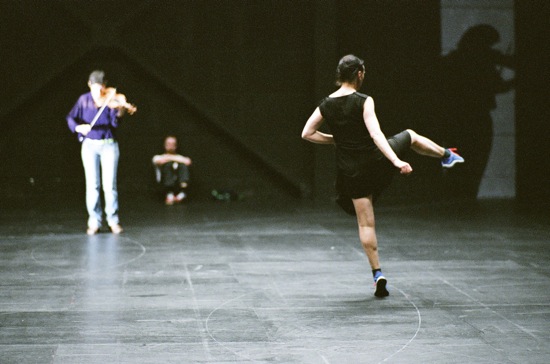
Partita 2. Foreground: Anne Teresa De Keersmaeker. At back: Amandine Beyer and Boris Charmatz. Photo: © Herman Sorgeloos
It’s thrilling to see movements and phrases that we came to know in silence join with Bach’s music when Beyer returns to the stage. Now the lilt of the Courante underscores the dancers’ springy runs. Now Charmatz’s baby steps fall briefly into synchrony with Bach’s notes. But there’s no Mickey-Mouseing in Partita 2. The music-dance companionship exists at a more complex level. Eventually, we hear the heartbreakingly beautiful final Chaconne, and the dancing, set intimately beside it, deepens. I can’t remember at what point the light that had changed only subtly throughout disappeared from the back wall. But, near the end, that beam pans slowly along the bricks from one side of the stage to the other. As if the lighting, too, needs to make a statement about beginnings and endings, and days that finish and dawn again.

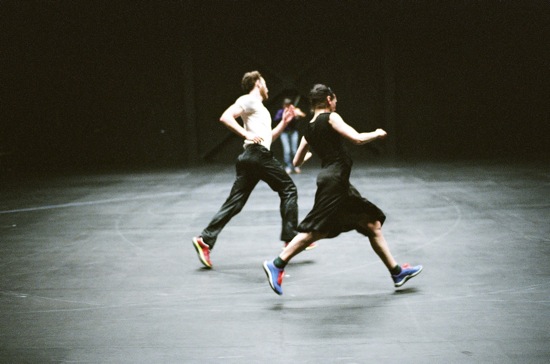
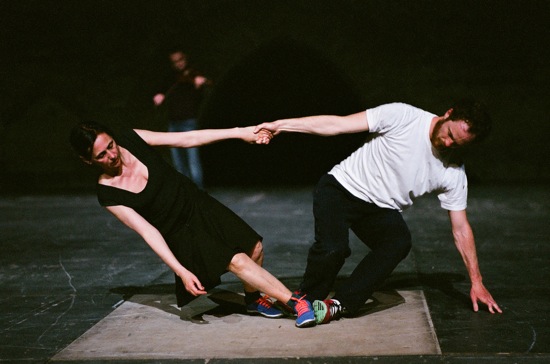
Thanks for this post Deborah. It’s some kind of interesting dance and I enjoyed reading this..